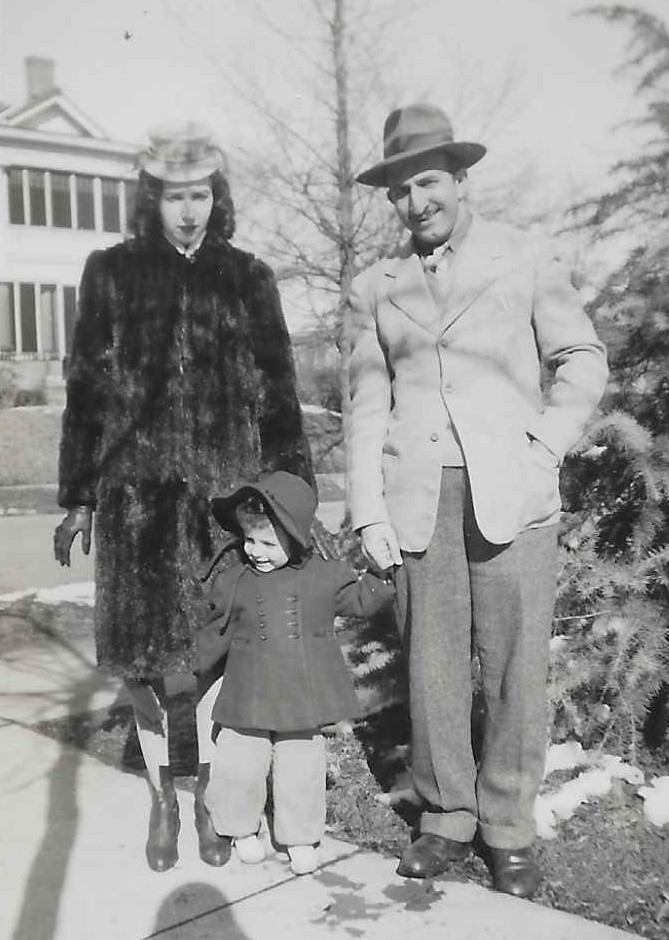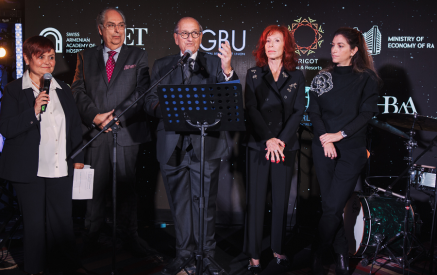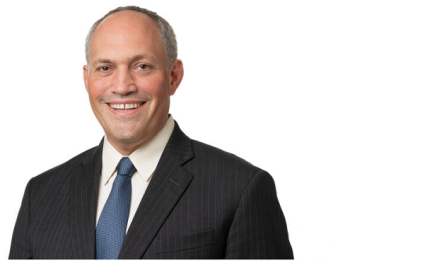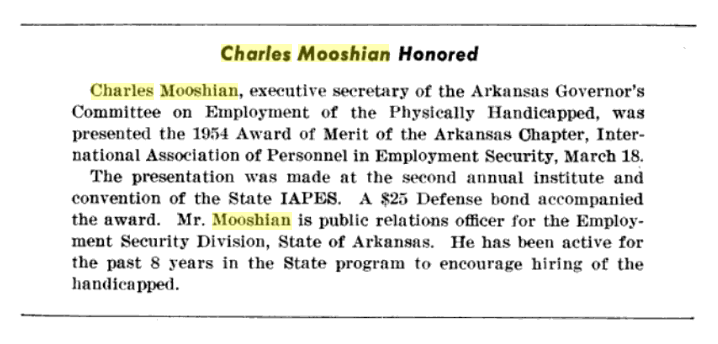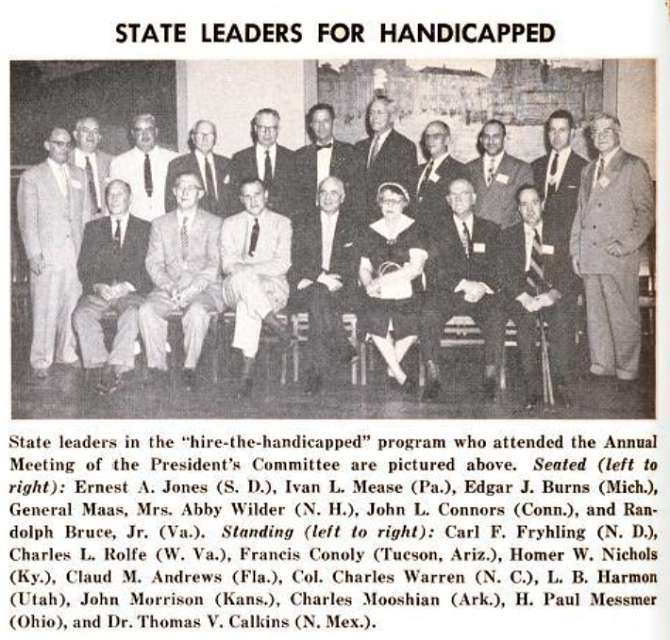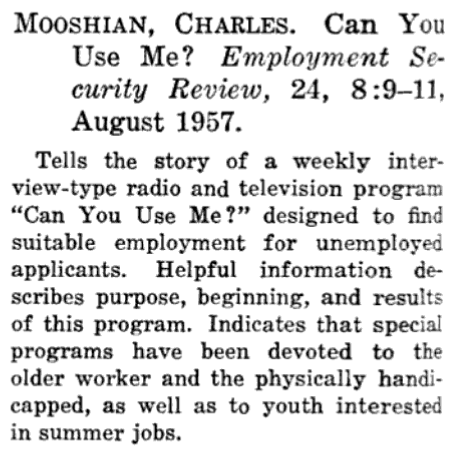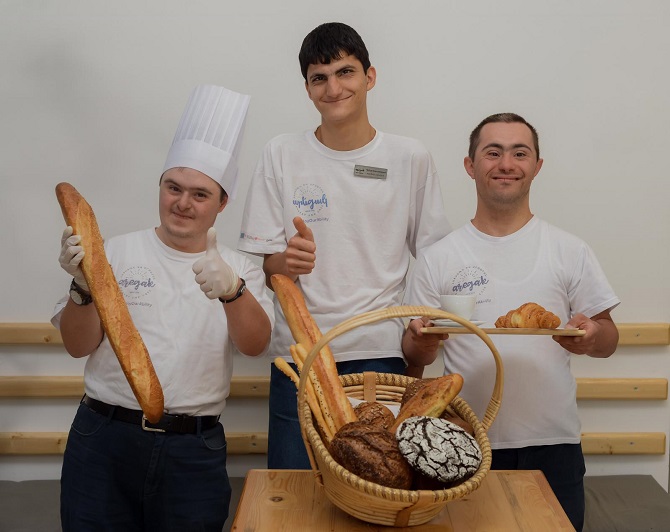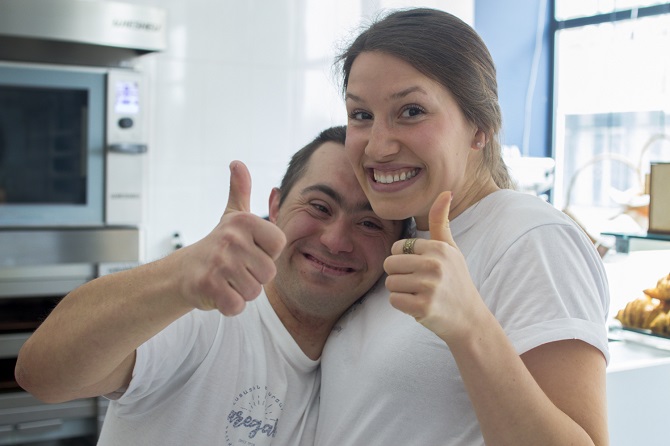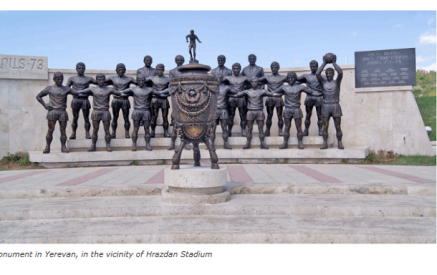The Armenian Weekly. I was never one to believe in destiny. But, as the Armenian proverb says, you can’t escape it.
Earlier this month, I randomly googled my mother’s maiden name. In the list of search results, “Charles Mooshian” caught my eye.
I never met this man, my grandfather. He left our world more than 20 years before I entered it. And he also left a mottled legacy. From a very young age, I knew one thing: he had been no hero to his family. According to my mother and her relatives, Charles was a workaholic with anger problems. His wife never felt treasured, and his children never felt good enough. My aunts and uncles still carry that pain with them to this day.
Despite his less than stellar parenting record, I was always proud of, intrigued by and thankful for this man. Proud, because I see his sharp wit and legendary productivity in my mother. Intrigued, because I knew that he was an avid writer just like I am. And thankful, because my grandfather is the sole reason I now live in Armenia.
Read also
Charles is 25 percent of me. And that 25 percent qualified me to volunteer through the Birthright Armenia program in 2018. Through Birthright, I discovered the Emili Aregak Center for children and youth with disabilities in Gyumri where I now work as its Communications and Public Relations Officer. Our center’s mission is to promote the inclusion of youth with disabilities in mainstream Armenian society through therapy, socialization, training and labor market integration. As you may have read in the Armenian Weekly, we also run Aregak Bakery & Cafe, the first such enterprise in Armenia to intentionally employ young adults with disabilities.
So… back to destiny. When I clicked on my grandfather’s name in the search results, this blurb from a 65-year-old e-book popped up on the screen:
I was thunderstruck. My Armenian grandfather promoted inclusive employment practices in America, and now his American granddaughter is in Armenia doing the same! We are two public relations officers who never met, linked by blood and a cause, yet separated by time and space.
A closer look at the text revealed it to be the May 1954 edition of the publication The President’s Committee on the Employment of the Physically Handicapped. As I eagerly scrolled through the pages, I read of the nationwide effort—of which my grandfather had played a major role on the state level—to integrate people with disabilities into the American workforce. Beautiful passages like these caught my eye:
“…we must create the rehabilitation services and employment opportunities which are required to restore America’s handicapped to useful citizenship, integrate them into the activities of our economic and social life, and show them the dignity which is a birthright of all mankind.”
In my excitement, I could hardly focus on the moving words. All I could think was: Does Momma know?
Of course my mother knew, and she was certain she had told me. Whatever the case may be, I was hungry for all the details my family (and Google!) could give me about my grandfather’s young adult life.
In a frenetic search, I found Charles’ name in a countless number of online publications. I saw it in bylines, citations, letters to the editor and articles. I discovered that he started the first official Coast Guard publication for Philadelphia, and I even found his military service noted in a 2015 Armenian Weekly article!
According to my aunt, Charles had studied law but always worked in public relations. When he was my age (25), he met my grandmother Grace at the tail-end of a crazy publicity stunt during his work at Paramount Pictures driving a covered wagon clear across the country from California to Little Rock to advertise the 1938 film The Arkansas Traveler.
I also learned that he was friends with William Fulbright and Douglas MacArthur, went on double dates with Ozzie and Harriet, and had monthly meetings with President Dwight Eisenhower during his stint on the President’s Committee on the Employment of the Physically Handicapped.
Amidst all these fascinating facets of my grandfather’s life, I wanted to know what had spurred his passion for people with disabilities. With a growing family, a number of community and church positions and a full-time job, Charles had little time to spare for his demanding volunteer role on the President’s Committee.
According to my family, both Charles’ Christian faith and business savvy drove his work.
“Despite his difficulties as a husband and father, my father’s life was informed by the Bible and his love for Jesus,” my mom told me. “He knew that every person was made in the image of God and had something to contribute to society.”
My aunt agreed, but also added that Charles was adept in communication psychology. He knew that the language of “dignity” alone would not change hearts in the workplace. Thus, his “Hire the Handicapped” PR campaigns portrayed people with disabilities as an important resource that employers were overlooking.
Charles’ interview-style radio and TV show called “Can You Use Me?” was an innovative means of broadcasting the skills of unemployed people through on-screen interviews. The concept of including people with disabilities in this pool of potential workers was very progressive for the 1950s when many employers were hesitant to consider them.
But those who took the risk ended up highly satisfied, according to my aunt’s memories.
“It turned out [people with disabilities] were better workers than most physically able people,” she told me. “They had the best attendance and there were certain jobs they could do that others couldn’t. They were so grateful to have the opportunity that nobody would give them.”
Images and stories used in my grandfather’s campaigns sought to prove this in striking ways.
My aunt recalls the story of the blind factory employee who was able to navigate through the challenges of a power outage. For him, darkness was the norm; for his colleagues, it was a source of panic.
Although she was quite young at the time, my mother was so impressed by one 1950s-era photograph that she could vividly describe it to me many decades later. It depicted a stylish young woman working a telephone switchboard with her feet. She didn’t have arms.
“Her toenails were polished, and she had a bracelet on her ankle and a ring on a toe,” my mom told me. “I imagined that if I were able to talk to her, she would say that there was nothing I could do with my hands that she couldn’t do with her feet!”
Always on the cutting edge of his field, my grandfather was passionate about wielding the power of sound and motion picture to communicate stories like these in an even more compelling manner than the written word. In his 1953 article Films on the Physically Handicapped, he explained the power of film to inspire change, citing examples and outlining detailed PR campaign ideas.
“Showing what the physically limited can do is far more important than the mere telling of it,” he wrote.
That line struck a deep chord in me, calling to mind one of the hashtags we have used in our campaigns at Aregak Bakery & Cafe: #SeeThisAbility.
—
In the midst of all my joyous discoveries about my grandfather’s work, I was somewhat unsettled. They somehow did not jibe with his personal flaws.
My aunt affirmed the conflict in my heart. “He had no idea how to be a father or a husband,” she admitted, “but he did all this.”
As a child, my mother’s siblings often heard how lucky they were to have the father they did. And at my grandfather’s funeral, many people testified to his being a family man.
“We never knew it… that he cared about his family,” my aunt told me.
Although this was a hard pill to swallow, I choose to look at the situation this way: many of the most inspirational, accomplished world-changers have flaws that, when uncovered, tarnished their pristine public appearance. Many even hide their faults beneath the folds of the great good they do.
But two truths remain: 1. The good doesn’t justify the bad we do, and the bad shouldn’t ruin the good. 2. We are imperfect, fallen and human, and each of us is in need of redemption.
In many ways, I hope to grow even more like my grandfather; naturally, I hope I will never exhibit his major flaws. I believe that with faith in God and hard work, we can choose to focus on the good in our genes, just as we focus on abilities, not disabilities.
What I wish with all my heart is that through some warp of time and space, I, with all my good and bad, and Charles, with all of his, could meet on Gyumri’s Abovyan Street. I would ask him to speak his sweet Western Armenian even though I’d only understand a few words. Then we’d switch to English. We’d sigh about the historical twists of fate which led his granddaughter, but never him, to Armenia.
And finally, I’d take him to Aregak Bakery & Cafe and proudly introduce him to my friend Hovo, and to Grisha, Mikayel and Anush, who prove every day that it is their ability, not their disability, that counts.
Sarah Stites
Main photo: Charles and Grace Mooshian with Sarah’s aunt




















































